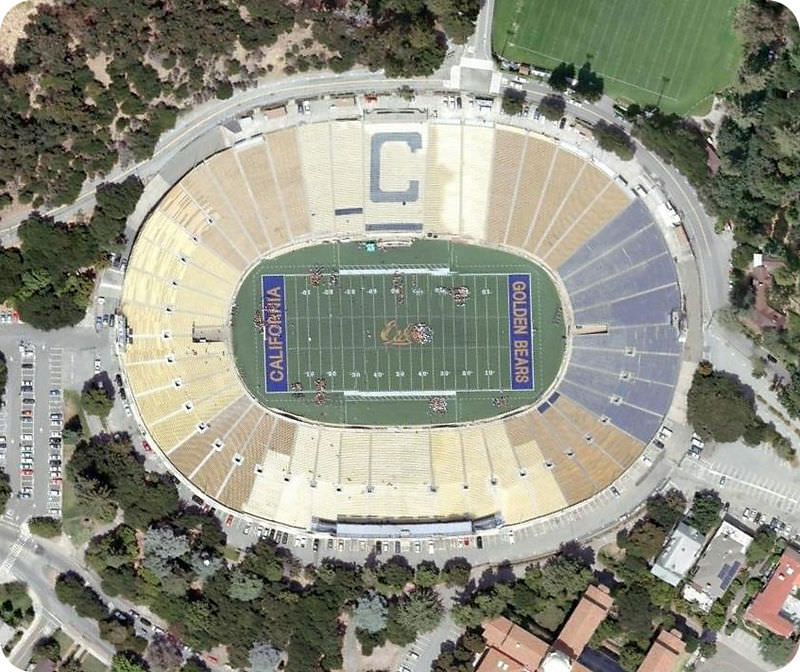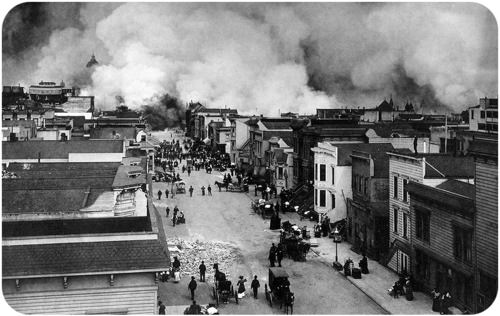6.21: Earthquake Safe Structures
- Page ID
- 5421
Why is California Memorial Stadium called a "tectonic time bomb"?
The California Memorial Stadium is the home of football at the University of California, Berkeley. The site probably looked flat and easy to build on in 1922. But now scientists know that the Hayward Fault passes directly beneath both end zones. The stadium has been renovated in a $321 million project. The renovation involved 10 miles of steel cables, silicone fluid-filled shock absorbers, concrete piers, 3-feet of sand, plastic sheeting, and stone columns. Go Bears!
New Construction
New construction can be made safer in many ways:
- Skyscrapers and other large structures built on soft ground must be anchored to bedrock. Sometimes the bedrock lies hundreds of meters below the ground surface.
- The correct building materials must be used. Houses should bend and sway. Wood and steel are better than brick, stone, and adobe, which are brittle and will break.
- Larger buildings must sway, but not so much that they touch nearby buildings. Counterweights and diagonal steel beams are used to hold down sway.
- Large buildings can be placed on rollers so that they move with the ground.
- Buildings may be placed on layers of steel and rubber to absorb the shock of the waves.
- Connections, such as where the walls meet the foundation, must be made strong.
- In a multi-story building, the first story must be well supported.
The Transamerica Building in San Francisco, pictured below, rests on a 52-foot deep steel and concrete foundation. Steel rods reinforce the building internally and X-shaped trusses support it externally. In the 1989 Loma Prieta earthquake, the building shook for more than a minute and swayed more than 12 inches in each direction, but was not damaged.
The Transamerica Pyramid in San Francisco is more stable in an earthquake or in high winds than a rectangular skyscraper.
Retrofitting
Older buildings can be made more earthquake safe by retrofitting. Steel or wood can be used to reinforce a building's structure and its connections. Elevated freeways and bridges can also be retrofitted so that they do not collapse (Figure below).
This bridge in San Diego, California, was built in 1931. It was retrofitted and reopened in 2010 to meet earthquake standards.
Preventing Fire Damage
Fires often cause more damage than the earthquake. Fires start because seismic waves rupture gas and electrical lines. Breaks in water mains make it difficult to fight the fires (Figure below). The shapes of pipes can make a big difference. Straight pipes will break in a quake. Builders zigzag pipes so that they bend and flex when the ground shakes. In San Francisco, water and gas pipelines are separated by valves. Areas can be isolated if one segment breaks.
In the 1906 San Francisco earthquake, fire was much more destructive than the ground shaking.
Making Choices
Strong, sturdy structures are expensive to build. Communities must decide how safe to make their buildings. They must weigh how great the hazard is, what different building strategies will cost, and how much risk they are willing to take.
Summary
- New structures that are built to meet earthquake safety codes do much better in earthquakes.
- Old buildings can be retrofitted for better safety.
- Cost is an important factor in deciding how safe to make the structures in an area.
Review
- What can be done to make a new building safer in an earthquake zone?
- What can be done to retrofit an older building in an earthquake zone?
- What can be done to reduce the damage from fire after an earthquake?
- Should all buildings in all areas be built to the highest earthquake standards? What is a more cost-effective approach?
Explore More
Use the resource below to answer the questions that follow.
- What is LA's most earthquake resistant building?
- Why is this building chosen to be the safest?
- Why is it called a floating building?
- How many suspension points are in the building? How do they move?
- What size earthquake should the building be able to withstand?
- How far is it designed to move?
- Why aren't all buildings in Los Angeles designed like this?





